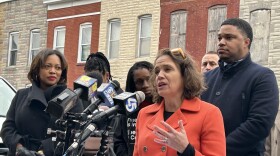Baltimore faith and business leaders are teaming up with Mayor Brandon Scott on a $3 billion plan to revitalize thousands of the city’s vacant homes and lots.
Members from the Greater Baltimore Committee and Baltimoreans United in Leadership (BUILD) gathered with the mayor at Southwest Baltimore’s Greater Harvest Baptist Church on Monday night to discuss their joint efforts to fight blight.
“This historic partnership and the plan we’re putting forward is designed to fully address Baltimore’s vacant housing crisis for the first time in our city’s history,” said Mayor Scott in a statement. “The era of piecemeal work and backwards-looking strategies is over.”
Scott’s administration pledged a $300 million contribution from the city which will be spread out over the next decade and a half, regardless of who is in office. The coalition hopes to secure help from a “special purpose entity” like the Maryland Stadium Authority or Maryland Economic Development Corp to ensure some continuity and consistency on the long-term project.
The city plans to pay the money back with the help of a tax increment financing (TIF) district– the city would borrow money to buy and refurbish thousands of the abandoned homes which would then be paid back through tax revenue collected on the rehabbed properties. Previously, that strategy has been largely reserved to encourage development along the waterfront but will now be leveraged in historically disinvested areas of East and West Baltimore where property vacancy is an especially pressing issue.
In all, the coalition plans to need at least $3 billion in public funding, including a significant amount of money from the state, to rehab tens of thousands of vacant homes and lots across the city — although that state money is unsecured. The nonprofits, including GBC, BUILD, and others will work on securing additional private money for the initiative.
According to the city’s news release, there are around 13,000 vacant or abandoned buildings and another 20,000 vacant lots in Baltimore.
“This is a landmark day for the city of Baltimore and its residents. For far too long, vacant and abandoned properties have plagued our neighborhoods, leading to increased violence and stripping wealth from residents,” BUILD Clergy Co-Chair Rev. George Hopkins said in a statement.
The plan, which heavily relies on state money, was publicly announced as the state has signaled a need to start tightening its belt. Just last week, the state’s transportation officials announced that projects and maintenance for a number of services are likely to be delayed to make up for a $3 billion funding shortfall in the state’s six-year transportation plan.
Together, the coalition hired consulting group Public Financial Management to conduct an analysis of the plan which stated in its report that the investments would “more than pay for itself over time.” It also referenced a 2022 report from the Johns Hopkins 21st Century Cities Initiative, “The Costs of Baltimore’s Vacant Housing,” which estimated vacant properties cost the city around $100 million annually in lost real estate and income tax revenue.
That analysis from PFM is here.












